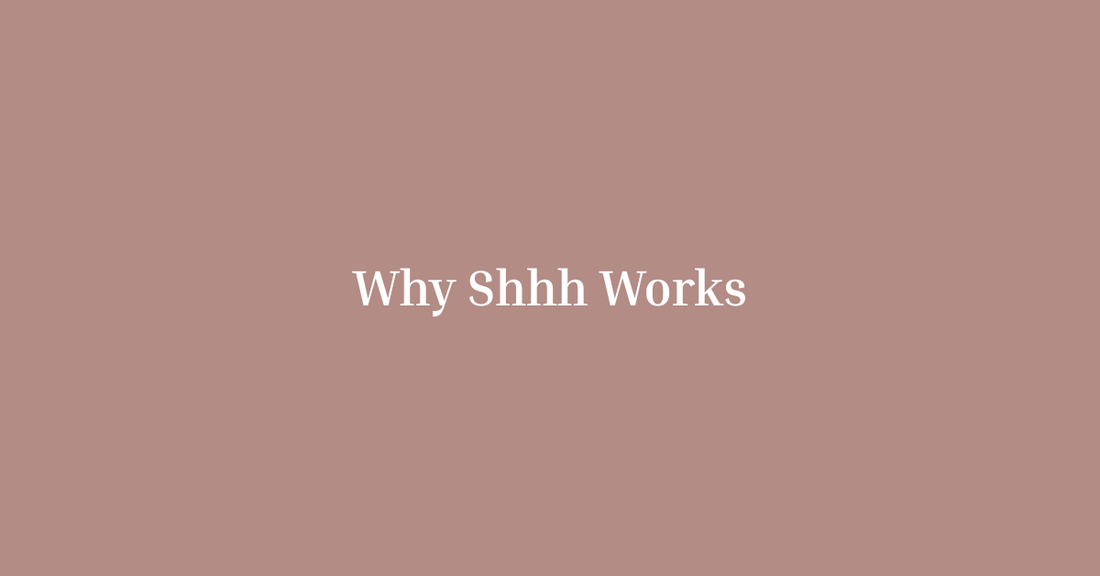
Why That Shhh Works: The Psychology of Sound and Baby Sleep (and Why It Calms Adults Too)
Share
You rock, you sway, you shhhhhh until your lips go numb. And somehow—magically—it works. But why does that gentle whoosh or hum send babies into dreamland faster than a lullaby? And why do some adults fall asleep to rain sounds or brown noise?
Let’s take a look at the psychology of sound, and why certain frequencies speak directly to our nervous systems—from the womb to the white noise machine.
What’s the Connection Between Sound and Sleep?
Humans are hardwired to react to sound. Our brains stay alert to noise even while we sleep—a prehistoric safety mechanism we’ve never shaken. But not all sounds signal danger.
Repetitive, low-frequency, non-threatening sounds signal safety. They allow the brain to let go. This is where white, pink, and brown noise come in.
A 2021 study in Frontiers in Human Neuroscience found that consistent ambient noise can help reduce sleep onset time and promote deeper sleep in both infants and adults.
The Sounds Babies Love—And Why
1. White Noise
White noise combines all audible frequencies at equal intensity. Think: a whirring fan or a static hum. It masks environmental noise and mimics the constant rush of sound in the womb, where blood flow and digestive gurgles created a 24/7 symphony.
2. Shushing Sounds
The classic "shhh" mimics the internal rhythms of a mother’s body. That’s why pediatricians like Dr. Harvey Karp recommend it for calming crying babies—it’s a biological echo of the womb.
3. Pink and Brown Noise
These softer, deeper variants are more pleasant to the human ear. Pink noise emphasizes lower frequencies (like rain), while brown noise goes even deeper (like distant thunder or a waterfall). For some babies—and many adults—these are the true sleep stars.
How Sound Regulates the Nervous System
Sound affects the autonomic nervous system, which controls our heart rate, breathing, and stress response. Soothing sounds activate the parasympathetic nervous system—the "rest and digest" mode—helping both babies and adults calm down.
Research from the Journal of Clinical Sleep Medicine shows that consistent background noise may help light sleepers, including infants, avoid sudden arousals from external disturbances.
Designing a Sound Environment That Works
1. Choose the Right Sound
Not every baby loves white noise. Some prefer ocean waves, rainfall, or rhythmic shushing. The key is customization—finding a soundscape that soothes your baby.
2. Keep It Consistent
Use the same sound at naps and bedtime. This creates a predictable sleep association and helps signal to the brain that it’s time to wind down.
3. Watch the Volume
Experts recommend keeping sleep sounds at or below 50 decibels—about the level of a quiet dishwasher. Place sound devices at least a metre from your baby’s crib.
4. Choose Tools That Evolve With Your Baby
That’s where Shushiie comes in. Designed with the understanding that sound is a powerful, evolving cue, it lets you layer and fine-tune audio as your baby grows—ensuring their sleep space adapts as their needs change.
Final Thought: From Womb to White Noise—Sound Is the Thread That Soothes Us
Whether it’s the whoosh of blood in utero or the low hum of rain at bedtime, sound plays an unspoken role in calming our bodies. Understanding it isn’t just science—it’s a gift to exhausted parents everywhere. And yes, that “shhh” really does work.
